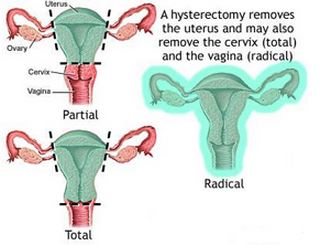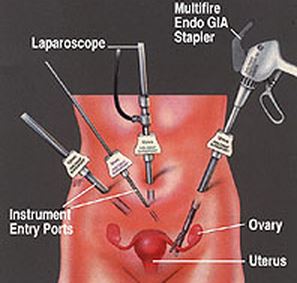Laparoscopic Hysterectomy – Indications, Procedure, Recovery, Cost
What is a Laparoscope?
Laparoscopic surgery involves the use of a laparoscope to visualize the abdominal cavity during surgery. The laparoscope is used to avoid a large abdominal incision or a laparotomy in order to see the abdominal contents.
A laparoscope is a special camera attached to a thin tube that is inserted through small incisions in the abdomen. There are two types of laparoscope which include:
1. Telescopic rod lens system
This is connected to either a three chips or single chip video camera used to visualize the organs.
2. Digital Laparoscope
This involves the connection of a charge-coupled device at the tip of the laparoscope. This does not use the rod lens system.
A fiber optic cable is also connected to a light source in the form of xenon or halogen to light up the field. The video taken by the laparoscope is then projected through a monitor to enable the surgeons to see what is happening inside the abdominal cavity.
The use of a laparoscope during surgery allows the performance of complex surgeries as well as minor surgeries without a large cut in the abdomen.
What is laparoscopic surgery?
Laparoscopy came from the Greek word lapara meaning loin or flank and skopein which means to view, see or examine. This is a minimally invasive surgical technique that involves only 3 to 4 small incisions in the abdomen. The incisions are usually up to less than an inch only to allow the laparoscope, tubes and other small instruments to be inserted through the abdominal wall. The abdomen is also insufflated using carbon dioxide gas in order to blow up the cavity like a balloon to easily navigate inside. Carbon dioxide is employed because this can be absorbed in the body and can be excreted through the breathing process. This gas is also non-flammable which renders it safe to use for surgeries.
Laparoscopy can be used on almost all abdominal surgeries including hysterectomy. The conventional way of performing hysterectomy is through laparotomy or abdominal hysterectomy, which creates a large incision on the abdomen. But with the advent of technology, hysterectomy can be done in a minimally invasive procedure through laparoscopy. The first hysterectomy involving laparoscopy was done in 1988 in Pennsylvania by Harry Reich.
Laparoscopic Hysterectomy can be performed using two techniques which include:
- Total Laparoscopic Hysterectomy (TLH)
Total laparoscopic hysterectomy involves the manipulation of the uterus through the use of a laparoscope. The uterus is then cut into smaller pieces in order to evacuate the tissues through the small incisions in the abdominal wall.
- Laparoscopic-Assisted Vaginal Hysterectomy (LAVH)
Laparoscopic assisted vaginal hysterectomy involves the manipulation of the uterus using a scope inserted in the abdominal cavity. Once the uterus is detached, it is removed vaginally.
Adhesions, endometriosis and adnexal mass cases can also be managed through laparoscopic hysterectomy.
Indications
Indications of Laparoscopic hysterectomy are similar to that of the conventional abdominal hysterectomy which includes:
- Abnormal Uterine Bleeding
Abnormal uterine bleeding is unexplained bleeding for more than 7 days caused by certain factors such as uterine fibroids, adenomyosis, bleeding diastesis and endometriosis.
- Vaginal Hysterectomy is not feasible.
When vaginal hysterectomy is not feasible due to adnexal masses, endometriosis, adhesions, narrow suprapubic arc or narrow vaginal wall as seen in nulliparous women, laparoscopic hysterectomy may be employed.
- Stage 1 uterine, cervical or ovarian cancer
Removal of the reproductive organs because of cancer is also performed using laparoscopic surgery.
- Endometrial carcinoma
Malignancies in the endometrium can also be removed using laparoscopic hysterectomy
- Severe endometriosis with cul-de-sac involvement
Severe endometriosis can be managed using abdominal hysterectomy; however patients may consider a laparoscopic surgery to minimize large incisions.
Contraindications
Contraindications for laparoscopic hysterectomy include:
- Postpartum hysterectomy
- Too large adnexal masses which cannot be evacuated through the small incisions.
The access to the uterus and size of it are also considered before undergoing laparoscopic surgeries.
Procedure
Preoperative Procedure
Several managements are employed before starting the surgery to limit complications and make the surgery easier. These include:
- Administration of Gonadotropin Releasing Hormone analogues 2 to 3 months before the procedure to reduce the size of the myoma or uterus.
- Treatment of anemia prior to the procedure to prevent severe hypoxia during the procedure.
- Abdominal and perineal skin preparation. The pubic hair and abdominal hair needs to be shaved to prevent infection.
- Bowel and bladder preparation. The patient is given laxatives or enema to clean the colon to prevent evacuation of feces during the procedure because anesthesia relaxes the anal sphincter. The client is also asked to void prior to transfer to the operating room to prevent the bladder from occupying large space on the abdominal cavity which may hinder visualization of the uterus.
- A prophylactic dose of antibiotics is given to prevent infection.
- Dentures, jewelries and nail polish are removed prior to transport of the patient.
Once the patient is in the operating room, other pre-operative procedures are done such as:
- Positioning the patient. The patient is initially positioned in a supine position for anesthesia induction. General endotracheal anesthesia is usually used. The patient is then placed to a Trendelenburg position (the body is tilted 30 degrees with the head part lower and the foot part higher than the rest of the body.
- The arms are padded to prevent brachial plexus injury.
- Electrosurgical dispersive pads are applied.
- Skin preparation is done by the use of iodine starting from the umbilicus going out extending up to the nipples and pubic symphysis down to the labia. The inner thighs are also painted with iodine when LAVH is performed.
- Urinary catheter is inserted to allow the draining of the urine during the entire procedure.
Intra-operative Procedure & Technique
The operation is started once the patient is prepared. Steps in undergoing the laparoscopic hysterectomy include:
- Drapes are applied aseptically using a special laparoscopy sheet over the abdomen.
- Three small incisions are made in the abdominal wall including an opening in the umbilicus.
- Trocars are placed in these incisions to allow the instruments and tubes to be inserted and supported in place.
- The abdominal cavity is insufflated with carbon dioxide gas to create a pneumoperitoneum.
- The laparoscope is inserted through the umbilicus to visualize the cavity.
- Other instruments are also inserted through the trocars which include a cutting instrument, guide, scissors or coagulation forceps and others. The surgeon guides the use of the instruments through a thin tube connected to them.
- The surgeon uses the image on the monitor to visualize the internal portion of the peritoneum.
- The uterine pedicle is tied with an absorbable suture to form a knot. The uterine vessels are then ligated between the knots. Bipolar forceps can also be used to create hemostasis. The uterine vessels are exposed to electric energy in order to prevent blood flow.
- The uterus is elevated to allow separation of the ureters and prevent severing the organ.
- The uterus is then detached from the ligaments, tubes and blood vessels where it is connected.
- The uterus is also detached from the cervix and vagina depending on the extent of the disease. For LAVH, the uterus is evacuated vaginally.
- Other reproductive organs such as the ovaries and fallopian tubes may be assessed and removed depending on the extent of the malignancy.
- The uterus is extracted from the small incisions through dissecting the organ in small parts.
- The abdominal cavity is washed with an antiseptic solution.
- The intraperitoneal carbon dioxide is removed.
- Vaginal and abdominal suturing is done to close the operative field.
A drain may also be placed on the incision site to allow gas, fluids and blood to drain from the abdominal cavity. It is removed 1 to 2 days after the drainage have ceased.
Post operative Recovery
Laparoscopic surgery reduces the recovery time of the patient post-operatively. The hospital stay after a laparoscopic hysterectomy is usually 2 to 3 days as compared to abdominal hysterectomy, which is 3 to 5 days.
Full recovery can extend up to 6 months and patients should employ measures to hasten the healing and prevent complications such as:
- Early ambulation to prevent stasis of blood.
- Proper breathing exercises to prevent build-up of pulmonary secretions.
- Consumption of Vitamin C and protein rich foods to hasten wound healing.
Complications
Complications of laparoscopic hysterectomy include:
- Injury to the ureters
- Injury to the bladder
- Injury to the bowels
- Hemorrhage
- Infection
- Delayed injury to the urinary tract
- Hematoma formation
- Ileus
- Thromboembolism
Side-effects
Laparoscopic surgeries usually result in abdominal pain as a result of the stretching of the abdominal walls with the use of carbon dioxide insufflations. The patient may report vague abdominal pains, cramps and flatulence. The patient may also pass flatus frequently until all the gas is released.
Cost
Laparoscopic surgeries are more expensive than open surgeries because only expert surgeons are able to do such. The average cost of laparoscopic hysterectomy is around $7,000 to $9,000. However, the hospital stay is reduced so hospital costs are generally cheaper.
Surgery Time
The entire procedure can last for 1 to 5 hours depending on the extent of disease. Laparoscopic surgery is slightly longer than open surgeries because the surgeon has limited view of the area.
Advantages & Benefits of laparoscopic hysterectomy
The advantages of laparoscopic hysterectomy over abdominal hysterectomy include:
- Smaller incision
- Shorter recovery period
- Lesser scarring
- Lower risk for bleeding
- Lesser pain sensation because of smaller incisions
- Reduced hospital stay which reduces hospital costs
- Faster assumption of daily activities
- Lower risk of infection because of lesser exposure of the abdominal organs to the environment.
Despite these advantages, laparoscopic surgery is still controversial for pediatric surgery. Laparoscopic surgery also tends to have lesser efficacy because the surgeon is not able to have a complete visualization of other organs. Before undergoing laparoscopic surgeries, it is advised that patients review the pros and cons of the procedure.
Pictures

